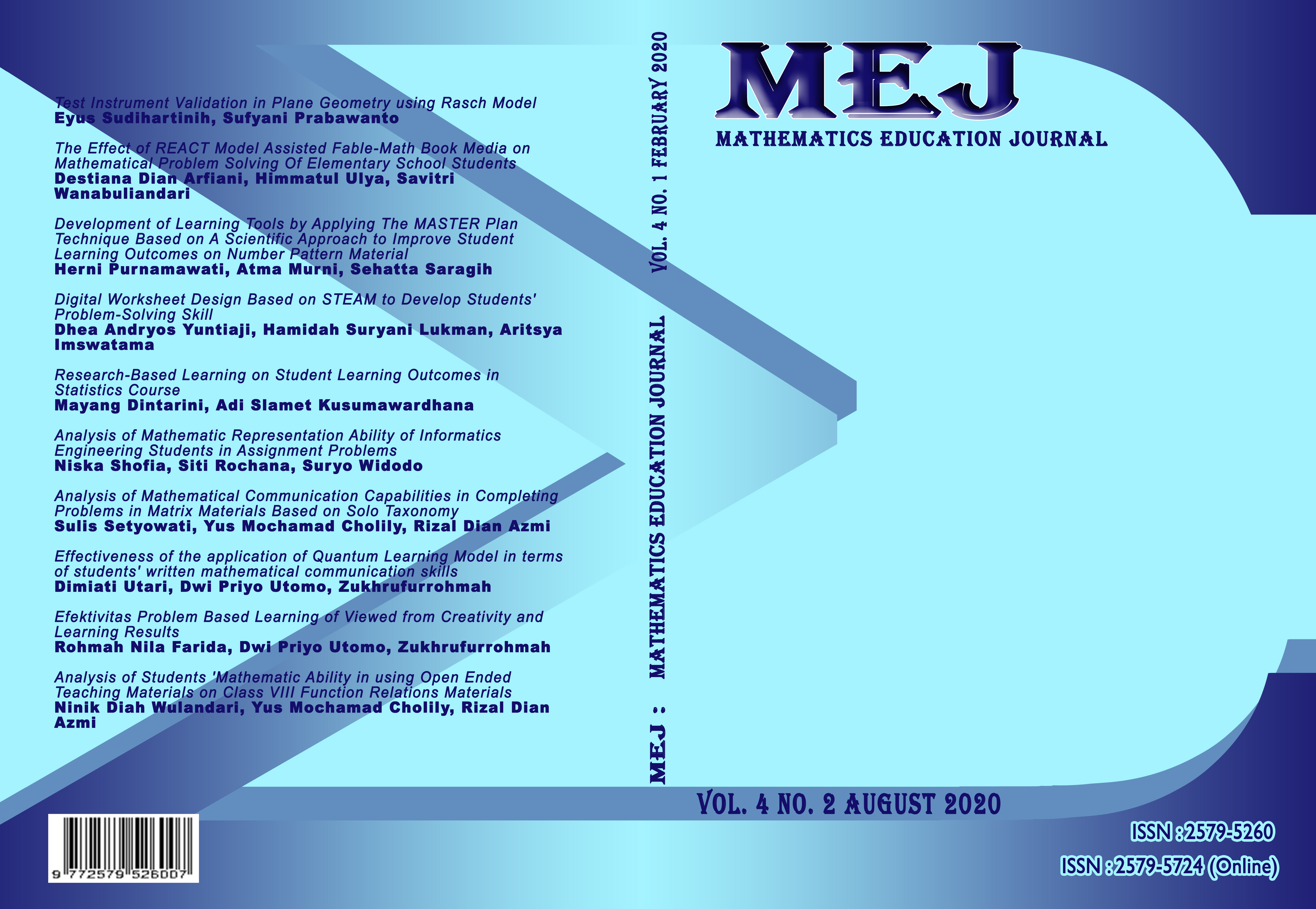Analysis of Mathematical Communication Capabilities in Completing Problems in Matrix Materials Based on Solo Taxonomy
DOI:
https://doi.org/10.22219/mej.v4i2.12832Keywords:
Writing Mathematical Communication, Matrix, SOLO TaxonomiesAbstract
The purpose of this study is to describe the mathematical communication skills based on SOLO Taxonomy in students of class XI of Mathematics and Natural Sciences Muhammadiyah 3 Batu in solving problems on matrix material. This type of research is descriptive qualitative, where the subject is 17 students of class XI MIPA. The method of collecting research data uses test instruments. Based on the results of data analysis, it can be concluded thatas many as 4 students with very good mathematical communication skills criteria, 6 students with good mathematical communication skills criteria, 7 students with sufficient mathematical communication ability criteria and students. Whereas for students with written mathematical communication skills criteria lacking none. Students are in very good criteria, able to solve Unistructural - Relational level problems in SOLO Taxonomy. Meanwhile, students with good written mathematical communication skills are able to solve Unistructural level questions and Multistructural levels in SOLO Taxonomy. Then students with written mathematical communication ability criteria are quite capable of solving Unistructural level problems in SOLO Taxonomy.The average of written mathematical communication skills is in good criteria with the average value of written mathematical communication skills, namely 61.95, so that the average student is able to solve problems at a level Unistructural - Multistructural on SOLO Taxonomy.
Downloads
References
Azizah, FR (2015). Analysis of Mathematical Problem Solving Capabilities Based on SOLO Taxonomy in the Beam Sub Subject of Class VIII-H Middle School Students. 1–241. Biggs, John, Kevin Collis. (1978). EVALUATING THE QUALITY OF LEARNING The SOLO Taxonomy (Structure Of The Observed Learning Outcome). Analytical Chemistry, 50 (3), 394A-394A. Https://Doi.Org/10.1021/Ac50025a791 Paradise. (2019). ANALYSIS OF STUDENT MISTAKES IN COMPLETING LINIER ALGEBAR PROBLEMS. 2 (1). Hodiyanto, H. (2017). MATHEMATICAL COMMUNICATION ABILITY IN MATHEMATICS LEARNING. 7 (1). Jamil, AF (2017). Increasing the Level of Students' Algebraic Thinking Based on SOLO Taxonomy in Linear Equation Material Through Scaffolding. Mandala Education Scientific Journal, 3 (1), 1–13. Https://Doi.Org/10.1017/CBO9781107415324.004 Krismantono, RR (2017). Error Analysis in Solving Mathematical Problems. 177–81. Lamonta, PA, Tandiayuk, MB, & Puluhulawa, I. (2016). Analysis of Mathematical Communication Capabilities of Class VIII Students of SMP Negeri 19 Palu in Understanding Beam Volume. Electronic Journal of Mathematics Education Tadulako, 03 (04), 464–477. Lanani, K. (2013). Learning to Communicate and Communication for Learning in Mathematics Learning. Infinity Journal, 2 (1), 13. Https://Doi.Org/10.22460/Infinity.V2i1.21 Lingga, A.; WS (2013). THE INFLUENCE OF ALGABAR THINKING ABILITY ON MATHEMATICAL SOLUTION ABILITY (Case Study in Class VIII of SMP Negeri 1 Kaliwedi, Cirebon Regency) Alif. Lutfianannisak, L., & Sholihah, U. (2018). Mathematical Communication Skills of Students in Solving Material Composition Problems in Terms of Mathematical Ability. Tadris Mathematics Journal, 1 (1). Https://Doi.Org/10.21274/Jtm.2018.1.1.1-8 Mandasari, R., & Chandra, TD (2018). Mathematical Communication Capabilities Write Middle School Students In Resolving Problems. Journal of Education, 3 (1), 838–850. NCTM. (2000). Principle And Standards For School Mathematics. Pertiwi, W. (2018). ANALYSIS OF ABILITY TO THINK MATH MATERIAL CRITICAL PARTICIPANTS IN VOCATIONAL SCHOOL IN MATRIX MATERIALS. 2 (C), 821–831. Putri, LF; JTM (2013). Identification of Students Mathematics Ability in Solving Algebra Problems in Classes Viii Based on Solo Taxonomy. Mathedunesa, 2 (1), 29-30. Qohar, A. (2011). Mathematical Communication: What And How To Develop It In Mathematics Learning? International Seminar and The Fourth National Conference on Mathematics Education. Department of Mathematics Education, Yogyakarta State University., 1–12. Retrieved From Https://Core.Ac.Uk/Download/Pdf/11058861.Pdf Romlah, S.; NO ; WS (2017). Analysis of Mathematical Communication Capabilities of Junior High School Students. IKIP Siliwangi Bandung, 01 (02), 37–46. Sukayasa, FGS (2019). PROFILE OF ERRORS OF STUDENTS IN COMPLETING PROBLEMS OF MATRICES BASED ON GENDER IN. Supandi, Rosvitasari, DN, & Kusumaningsih, W. (2017). Improved Mathematical Written Communication Ability Through Think-Talk-Write Strategies. Journal of Education, 1 (2), 227-239. Tampi, W., Subanji, & Sisworo,,. (2017). Student Metacognition Process in Solving Algebra Problems Based on SOLO Taxonomy. Journal of Mathematics, 7 (1), 30. Https://Doi.Org/10.24843/Jmat.2017.V07.I01.P80 Waluya, P.; B. (2017). Analysis of Mathematical Communication Skills Students in The Algebra Based Nctm. IOSR Journal of Mathematics, 13 (01), 60–66. Https://Doi.Org/10.9790/5728-1301056066
Downloads
Published
Issue
Section
License
Authors who publish with MEJ (Mathematics Education Journal) agree to the following terms:
For all articles published in MEJ, copyright is retained by the authors. Authors give permission to the publisher to announce the work with conditions. When the manuscript is accepted for publication, the authors agree to automatic transfer of the publishing right to the publisher.
Authors retain copyright and grant the journal right of first publication with the work simultaneously licensed under a Creative Commons Attribution-ShareAlike 4.0 International License that allows others to share the work with an acknowledgment of the work's authorship and initial publication in this journal.
Authors are able to enter into separate, additional contractual arrangements for the non-exclusive distribution of the journal's published version of the work (e.g., post it to an institutional repository or publish it in a book), with an acknowledgment of its initial publication in this journal.
Authors are permitted and encouraged to post their work online (e.g., in institutional repositories or on their website) prior to and during the submission process, as it can lead to productive exchanges, as well as earlier and greater citation of published work (See The Effect of Open Access).

This work is licensed under a Creative Commons Attribution-ShareAlike 4.0 International License.










